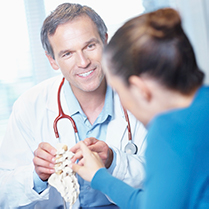
Osteoporosis, which literally means porous bone, is a disease in which the density and quality of bone are reduced. As bones become more porous and fragile, the risk of fracture is greatly increased. This loss of bone occurs silently and progressively. Often there are no symptoms until the first fracture occurs.
Osteoporosis affects thousands of people and not only the elderly or postmenopausal women. Risk factors include:
- Patients with a history of anorexia nervosa or low body weight.
- Patients with celiac disease or other malabsorption disorders, chronic liver disease, inflammatory bowel disease, hyperparathyroidism, hyperthyroidism, kidney disease.
- Patients with a family history of a parent breaking a hip.
- Patients with Rheumatoid Arthritis.
- Patients taking certain medications, such as corticosteroids, aromatase inhibitors, certain anti-seizure medications, anti-androgen therapy, blood thinners, PPIs.
- Patients with history of cigarette use or excessive alcohol use.
- In men, sex hormone levels also decline after middle age. These declines probably also contribute to bone loss in men after around age 50.
“So if I fell and did not break a bone, I must be in the clear right?” Wrong!
Even if you fall and did not break a bone, you can still be suffering from osteoporosis. There are many warning signs that may indicate you have osteoporosis including:
- Sudden back pain
- Height loss of more than 3 cm
- Stooped back
- Swallowing and breathing difficulties
What can you do if you noticed you have warning signs for osteoporosis and/or are at an increased risk for developing osteoporosis than the average individual?
You can make an appointment with our Bone Health Clinic where our bone health experts and their team work to diagnose and treat osteoporosis. The clinic provides full evaluations for osteoporosis including bone density tests (QCT, DXA), FRAX assessments, X-rays, laboratory tests, and provider expertise regarding diet, nutrition, exercise, medication and more.
